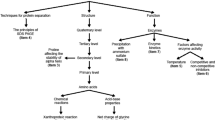Abstract
This study involved the development and application of a two-tier diagnostic test measuring students’ understanding of flowering plant growth and development. The instrument development procedure had three general steps: defining the content boundaries of the test, collecting information on students’ misconceptions, and instrument development. Misconception data were collected from interviews and multiple-choice questions with open response answers. The data were used to develop 13 two-tier multiple-choice items. The conceptual knowledge examined was flowering plant life cycles, reproduction, precondition of germination, plant nutrition, and mechanism for growth and development. The diagnostic instrument was administered to 477 high school students. The correlation coefficient of test-retest was 0.75. Difficulty indices ranged from 0.24 to 0.82, and discrimination indices ranged from 0.32 to 0.65. Results of the Flowering Plant Growth and Development Diagnostic Test suggested that students did not acquire a satisfactory understanding of plant growth and development concepts. Nineteen misconceptions were identified through analysis of the items that could inform biology instruction and resource.
Similar content being viewed by others
References
Abrams, E., Southerland, S.A. & Cummins, C.C. (2001). The how’s and why’s of biological change: How students overlook the cause of phenomena in their search for meaning. International Journal of Science Education, 23(12), 1271–1281.
Ausubel, D.P. (1968). Educational psychology: A cognitive view. New York: Holt, Rinehart & Winston.
Bartov, H. (1978). Can students be taught to distinguish between teleological and causal explanations? Journal of Research in Science Teaching, 15, 567–572.
Bell, B. (1985). Students’ ideas about plant nutrition: What are they? Journal of Biological Education, 19, 213–218.
Biddulph, F. (1984). Pupils’ ideas about flowering plants. Learning in Science Project (Primary). Working Paper No. 125, ERIC Document Reproduction Service No. ED 252 406.
Cummins, C.L. & Remsen, J.V. Jr. (1992, May). Research suggestions for studying student conceptions of ultimate and proximate causation. In Proceedings of Evolution Education Research Conference. Baton Rouge, LA.
Gilbert, J.K. (1977). The study of student misunderstandings in the physical sciences. Research in Science Education, 7, 165–171.
Griffard, P.B. & Wandersee, J.H. (2001). The two-tier instrument on photosynthesis: What does it diagnose? International Journal of Science Education, 23(10), 1039–1052.
Haslam, F. & Treagust, D.F. (1987). Diagnosing secondary students misconceptions of photosynthesis and respiration in plants using a two-tier multiple choice instrument. Journal of Biological Education, 21, 203–211.
Jungwirth, E. (1975). The problem of teleology in biology as a problem of biology-teacher education. Journal of Biological Education, 9, 243–246.
Jungwirth, E. (1988). The associative field as a diagnostic instrument in assessing the breadth of multi-contextual concepts: The concept ‘development’. International Journal of Science Education, 10, 571–579.
Lin, S.-W. (2003, March). Students’ understanding of flowering plants growth and development: An interview study. Paper presented at the NARST annual International Conference, Philadelphia, PA.
Lin, S.-W. & Sue, Y.F. (2003, August). How textbooks and instruction contribute to students’ understanding of flowering plants growth and development. Paper presented at the 2003 Dialogue between Mathematics and Science Education: Concept Learning, Kaoshiung, Taiwan.
Moore, J.A. (1993). Science as a way of knowing: The foundations of modern biology. Cambridge, MA: Harvard University Press.
Odom, A.L. & Barrow, L.H. (1995). Development and application of a two-tier diagnostic test measuring college biology students’ understanding of diffusion and osmosis after a course of instruction. Journal of Research in Science Teaching, 32, 45–61.
Peterson, R.F. & Treagust, D.F. (1989). Development and application of a diagnostic instrument to evaluate grade-11 and grade-12 students’ concepts of covalent bonding and structure following a course of instruction. Journal of Research in Science Teaching, 26, 301–314.
Schaefer, G. (1979). Concept formation in biology: The concept growth. European Journal of Science Education, 1, 87–101.
Shi, H. (Ed.). (2001). Life science. Taipei, Taiwan: Lungtung.
Simpson, M. & Arnold, B. (1982). The inappropriate use of subsumers in biology learning. European Journal of Science Education, 4, 173–182.
Simpson, W. & Marek, E.A. (1988). Understandings and misconceptions of biology concepts held by students attending small high schools and students attending large high schools. Journal of Research in Science Teaching, 25(5), 361–374.
Southerland, S.A., Abrams, E., Cummins, C.C. & Anzelmo, J. (2001). Understanding students’ explanations of biological phenomena: Conceptual frameworks or P-prims? Science Education, 85(4), 328–348.
Tamir, P. (1989). Some issues related to the use of justifications to multiple-choice answers. Journal of Biological Education, 23(4), 285–292.
Tamir, P. & Zohar, A. (1991). Anthropomorphism and teleology in reasoning about biological phenomena. Science Education, 7, 57–67.
Treagust, D.F. (1985, April). Diagnostic test to evaluate students’ misconceptions in science. Paper presented at the 58th annual meeting of the National Association for Research in Science Teaching, French Lick Springs, IN.
Treagust, D.F. (1988). Development and use of diagnostic tests to evaluate students misconceptions in science. International Journal of Science Education, 10, 159–169.
Treagust, D.F. (1995). Diagnostic assessment of students’ science knowledge. In Glynn & Duit (Eds.), Learning science in the schools: Research reforming practice (pp. 327–346). Mahwah, New Jersey: Lawrence Erlbaum Associates.
Wandersee, J.H. (1983). Students’ misconceptions about photosynthesis: A cross age study. In Helm & Novak (Eds.), Proceedings of the International Seminar: Misconceptions in Science and Mathematics (pp. 441–446). Ithaca, NY: Cornell University.
Wandersee, J.H., Fisher, K.M. & Moody, D.E. (2000). The nature of biology knowledge. In Fisher, Wandersee & Moody (Eds.), Mapping biology knowledge (pp. 25–37). Norwell, MA: Kluwer.
Wandersee, J.H., Mintzes, J.J. & Novak, J.D. (1994). Research on alternative conceptions in science. In Gabel (Ed.), Handbook of research on science teaching and learning (pp. 177–210). New York: Macmillan.
Wareing, P.F. & Phillips, I.D.J. (1981). Growth and differentiation in plants, 3rd edn. New York: Pergamon.
Yang, C.C. (Ed.) (2001). Life science. Tainai, Taiwan: Nani.
Yarroch, W.L. (1991). The implications of content versus validity on science tests. Journal of Research in Science Teaching, 28(7), 619–629.
Author information
Authors and Affiliations
Corresponding author
Rights and permissions
About this article
Cite this article
Lin, SW. Development and Application of a Two-Tier Diagnostic Test for High School Students’ Understanding of Flowering Plant Growth and Development. Int J Sci Math Educ 2, 175–199 (2004). https://doi.org/10.1007/s10763-004-6484-y
Issue Date:
DOI: https://doi.org/10.1007/s10763-004-6484-y




